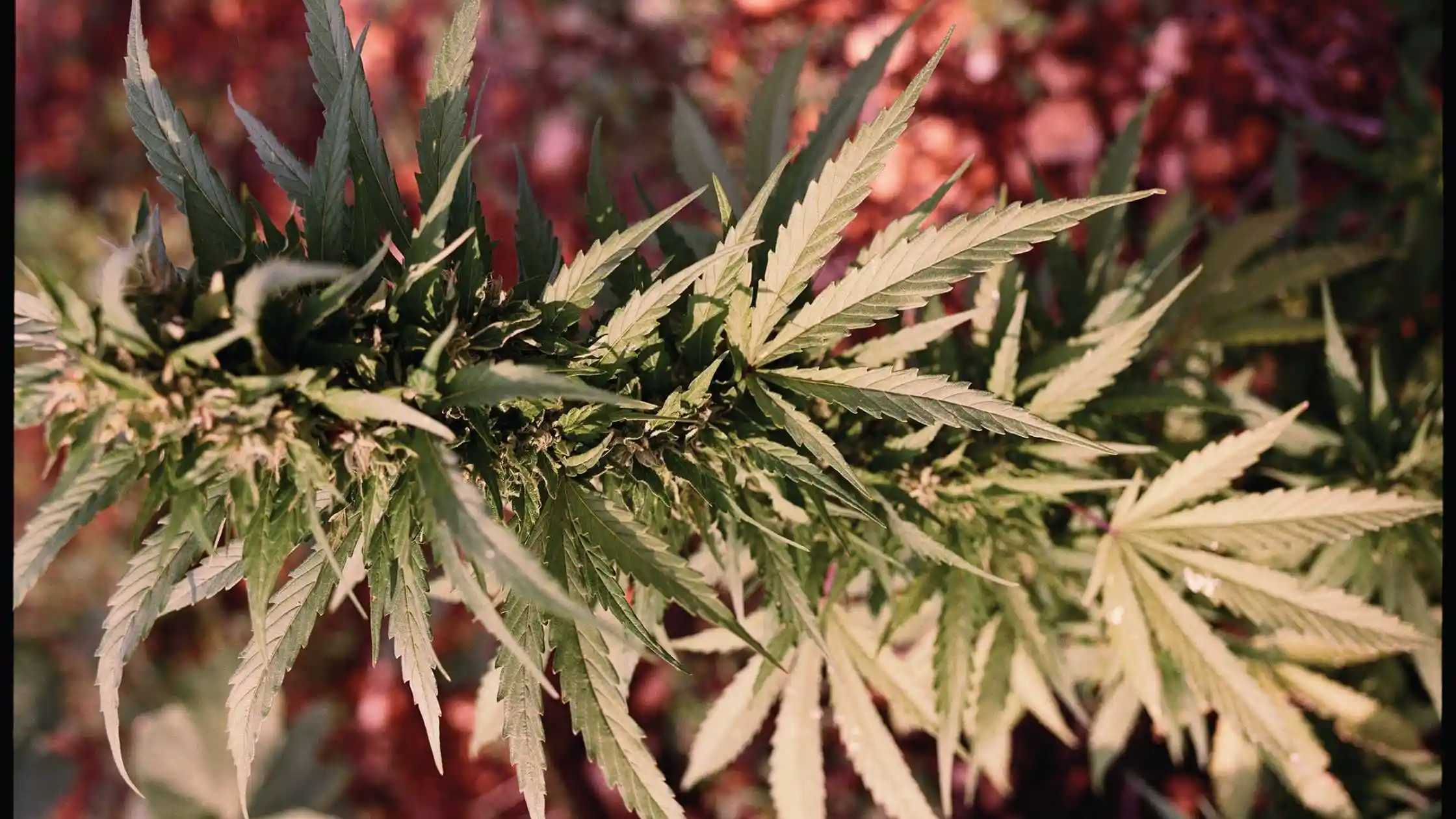The Frontline is celebrating 4/20 by looking at sustainability in the cannabis industry. If we’re not careful, the industry’s expansion in the U.S. may worsen greenhouse gas emissions. BIPOC cannabis advocates can help the sector reconnect to the land in holistic ways.
Photograph by Dan Martensen / Trunk Archive
About once a month, I buy myself a half-ounce of pot. This month, my partner got us some lemon kush. While we always ask about the strain we’re purchasing and its unique effects, we rarely stop to think about its impacts on the planet. A quick internet search, however, informs me that this cannabis strain can thrive in the suitable climate outdoors, which is less carbon-intensive than growing weed indoors.
An ounce of weed can come with a carbon footprint of up to about 328 pounds, according to a study published in Nature Sustainability last month. That all depends on how and where cannabis farmers grow their weed. Not every one of the 36 states where cannabis is recreationally or medically legal has the best climates for growing the plant outdoors. And the U.S. still relies heavily on the fossil fuel industry for energy, of which the cannabis industry requires plenty when growing indoors.
Welcome to The Frontline, where we take 4/20 seriously. I’m Yessenia Funes, climate editor of Atmos. Agriculture makes up 10% of greenhouse gas emissions in the U.S. Many environmental concerns with farming at large—the abuse of synthetic fertilizers and obsession with monocultures, for example—bleed into the cannabis industry, too. These problems often stem from a disconnection to the land and addiction to profit. Black, Indigenous, and other leaders of colour in the industry are demanding a seat at the table to ensure the industry’s rapid growth doesn’t push farmers to lose sight of what’s at stake if they mistreat the land and, thus, the planet.
Every year, Nina Parks celebrates two events on April 20: weed and her birthday. So you can imagine she has a pretty special relationship with pot. Some of her earliest cannabis memories date back to when she would accompany her uncle as a kid to visit his friends who were living with AIDS. She saw how the plant helped them eat and sleep. Parks couldn’t avoid cannabis culture; it was all around her. And she embraced it.
Until the war on drugs hit home. Her brother was incarcerated on New York’s Rikers Island on a weed-related charge. After that, cannabis wasn’t just something to enjoy—it was something to fight for. That’s how Parks became an industry advocate for equity and sustainability.
“We missed the whole tech boom, and we were not going to miss the cannabis boom,” Parks said.
Now, she is the vice president of the Original Equity Group, which certifies cannabis businesses for equitable practices. Parks also curates her cannabis flowers with her shop, Gift of Doja, where she works closely with farmers to find the most sustainably grown buds to sell. “They’re much more mindful about what they’re putting into the ground,” Parks said.
“Cannabis cultivated by the consciously corrupt is an insult to this great plant.”
CLARENDA STANLEY
GREEN HEFFA FARMS
It turns out that pot can be pretty damn bad for the planet. The cannabis industry currently faces environmental issues around energy use and greenhouse gas emissions, air and water pollution, and waste. However, improving growing techniques, cleaning up energy grids, and upgrading packaging can help alleviate some damage.
In March, a new study in Nature Sustainability found thatfound that growing cannabis indoors is incredibly energy-intensive. The sources of emissions vary from electricity to pumping carbon dioxide into grow rooms to accelerate plant growth. Plants are pretty simple: They require light, air, water, and nutrients. They’re kind of like us in that way. When farmers grow them inside, however, they need to artificially create an environment to supply all that to their plants. The plants would ideally receive this from Mother Nature outside, but that’s not always possible due to weather or regulations. Many growers prefer to grow indoors because they can maintain complete control over the conditions, which is essential when growing medical cannabis or when looking to breed a specific strain. There’s also a false notion that growing indoors is automatically better.
“You can grow good and shitty weed in any environment,” Parks said. “What it banks on is how good the cultivators are and how mindful they are about what they put into their plant, what the genetics of their plant are, [and] what the best-growing conditions for that particular plant are. That’s what makes good weed.”
All that control also comes at a cost. Electricity powers the lights to grow the plants and the heating, cooling, and ventilation systems that maintain the temperature, humidity, and airflow. If the local grid runs on fossil fuels, you get it. Then, the carbon dioxide isthere’sto rooms to increase photosynthetic rates. The study only looked at the upstream energy required to capture the CO2, pressurize it, and bottle it for farmers, said study coauthor Hailey Summers, a mechanical engineering Ph.D. candidate at Colorado State University. That means the carbon footprint for growing indoors may be higher because the carbon dioxide can also leak out of the facility and into the atmosphere.
Cleaning the industry can’t happen overnight, but industry leaders must begin addressing the problems now. The industry has exploded, and many advocates are worried newer markets will continue these harmful methods, which can threaten national efforts to reduce greenhouse gas emissions and protect communities.
“Our study intended to get ahead of these emissions-intensive practices and try to correct them before they become the norm,” Summers said. “So just encourage the industry to look for green solutions and build them intrinsically to their business practice before those unsustainable practices become the norm.”
That’s why Parks seeks small-scale farmers to be more mindful of environmental impacts. Growing outdoors is also a preference. Parks looks for farms that take care of and reuse their soil instead of abusing it and throwing it out. Cultivation can severely degrade soil health when farmers rely on synthetic fertilizers. Using such chemicals, including pesticides, can harm nearby communities if they wind up in waterways.
Ultimately, the industry needs to make space for the people who know the land best. That includes Black, Indigenous, and other people of colour—the same people the war on drugs has targeted for decades. Clarenda Stanley is the CEO of Green Heffa Farms, which grows cannabis in herbal teas. She grows all of her products organically due to her upbringing as a Black woman. She grew up hearing about George Washington Carver, a Black American scientist most famous for his appreciation of the peanut. He was also invested in passing agricultural knowledge down to Black communities and promoted restorative farming practices.
“My family always grew organically, conscientiously, consciously,“ Stanley wrote via email. “We were taught to honour and respect the land; that land was true wealth because it produced.”
Stanley worries that the industry’s obsession with profit and growth will obscure the real impacts cannabis is having on the earth. She said: “Growing cannabis should only be done by those who understand the importance of spirit in regards to respect for nature. Cannabis cultivated by the consciously corrupt is an insult to this great plant.”
Solonje Burnett is a co-founder of Humble Bloom, a cannabis advocacy platform that strives to elevate BIPOC-owned cannabis brands and break the stigma around the plant. In an email, she said sustainability is holistic and should include the environmental and social.
“Sustainability spans environmental and social reparative justice,“ Burnett said. “The erasure of Indigenous ancient knowledge coupled with the denial of our interconnectivity is fueled by misinformation and rooted in colonization, white supremacy, and oppressive patriarchal systems that focus on division and imbalance for profit while the people and planet suffer.”
A key theme in the fight for environmental justice is the corporate prioritization of profit over people and planet. The cannabis industry is no different. Slowly, seed by seed, gamechangers are transforming the industry with their hands and hearts. This 4/20, spark one in their honor. The planet’s future—and this beloved plant’s sustainability—depends on their success.
Disclaimer: https://atmos.earth/cannabis-sustainability-emissions-climate





